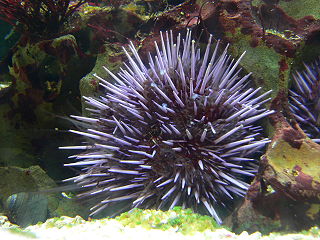
Strongylocentrotus is a genus of sea urchins in the family Strongylocentrotidae containing several species.
Anabrissus damesi is a species of sea urchin of the family Brissidae. Their armour is covered with spines. It is placed in the genus Anabrissus and lives in the sea. Anabrissus damesi was first scientifically described in 1881 by Alexander Agassiz, American scientist and engineer.
Aporocidaris milleri is a species of sea urchin of the family Ctenocidaridae. Their armour is covered with spines. It is placed in the genus Aporocidaris and lives in the sea. Aporocidaris milleri was first scientifically described in 1898 by Alexander Emanuel Agassiz.
Araeosoma coriacea is a species of sea urchin of the family Echinothuriidae. Their armour is covered with spines. It is placed in the genus Araeosoma and lives in the sea. Araeosoma coriacea was first scientifically described in 1879 by Alexander Emanuel Agassiz, an American scientist.
Araeosoma coriaceum is a species of sea urchin of the family Echinothuriidae. Their armour is covered with spines. It is placed in the genus Araeosoma and lives in the sea. Araeosoma coriaceum was first scientifically described in 1879 by Alexander Emanuel Agassiz, an American scientist.
Araeosoma eurypatum is a species of sea urchin of the family Echinothuriidae. Their armour is covered with spines. It is placed in the genus Araeosoma and lives in the sea. Araeosoma eurypatum was first scientifically described in 1909 by Alexander Agassiz and Hubert Clark.
Araeosoma leptaleum is a species of sea urchin of the family Echinothuriidae. Their armour is covered with spines. It is placed in the genus Araeosoma and lives in the sea. Araeosoma leptaleum was first scientifically described in 1909 by Alexander Emanuel Agassiz & Hubert Lyman Clark.
Araeosoma tessellatum is a species of sea urchin of the family Echinothuriidae. Their armour is covered with spines. It is placed in the genus Araeosoma and lives in the sea. Araeosoma tessellatum was first scientifically described in 1879 by Alexander Emanuel Agassiz.

Echinometra is a genus of sea urchins in the family Echinometridae.
Aspidodiadema annulatum is a species of sea urchin of the family Aspidodiadematidae. Their armour is covered with spines. It is placed in the genus Aspidodiadema and lives in the sea. Aspidodiadema annulatum was first scientifically described in 1927 by Koehler.
Aspidodiadema tonsum is a species of sea urchin of the family Aspidodiadematidae. Their armour is covered with spines. It is placed in the genus Aspidodiadema and lives in the sea. Aspidodiadema tonsum was first scientifically described in 1879 by Alexander Emanuel Agassiz.
Ceratophysa ceratopyga is a species of sea urchins of the Family Pourtalesiidae. Their armour is covered with spines. Ceratophysa ceratopyga was first scientifically described in 1879 by Alexander Emanuel Agassiz.
Ceratophysa rosea is a species of sea urchins of the Family Pourtalesiidae. Their armour is covered with spines. Ceratophysa rosea was first scientifically described in 1879 by Alexander Emanuel Agassiz.
Cidaris abyssicola is a species of sea urchin in the Family Cidaridae. Cidaris abyssicola was first scientifically described in 1869 by Alexander Emanuel Agassiz.
Cionobrissus revinctus is a species of sea urchins of the Family Brissidae. Their armour is covered with spines. Cionobrissus revinctus was first scientifically described in 1879 by Alexander Emanuel Agassiz.

Araeosoma is a genus of deep-sea sea urchins in the family Echinothuriidae.

Dermechinus is a genus of sea urchin in the family Echinidae found in deep water in the southern Indian, Pacific and Atlantic Oceans. It is monotypic, with Dermechinus horridus, sometimes called the cactus urchin, being the only species.





